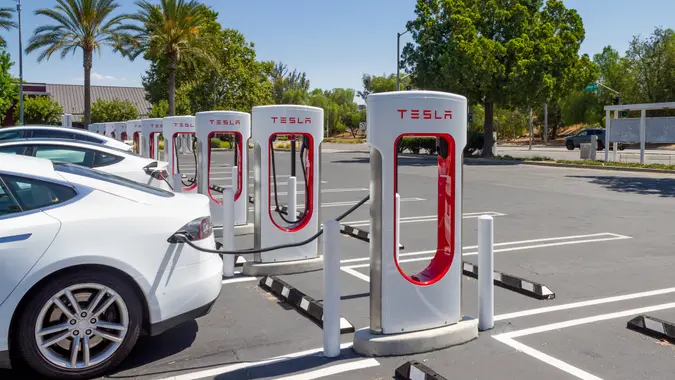Find Out How Much Car Your Salary Can Afford, According to Graham Stephan

Commitment to Our Readers
GOBankingRates' editorial team is committed to bringing you unbiased reviews and information. We use data-driven methodologies to evaluate financial products and services - our reviews and ratings are not influenced by advertisers. You can read more about our editorial guidelines and our products and services review methodology.

20 Years
Helping You Live Richer

Reviewed
by Experts

Trusted by
Millions of Readers
Are you in the market for a new vehicle? Buying your dream car may seem like something you could attempt on your monthly income, but a second look at your finances may be in order.
Real estate investor, money expert and personal finance influencer Graham Stephan thinks the car you want is probably much more expensive than you think. As he was a self-made millionaire by the time he was 26, you may want to listen to his financial advice on buying a new ride.
Read on for two car-buying rules Stephan recommends to help you determine how much car you can afford on your salary when it comes to loan amounts, maintenance and total transportation costs.
The 20/3/8 Car-Buying Rule
The first rule, Stephan said in a video on his YouTube channel, is the 20/3/8 rule. Via MoneyGuy.com, it is important to consider this rule, considering today’s high car prices and auto loan interest rates, to determine if it is realistic for your income.
Here’s how it works.
Put 20% Down
A 20% down payment will reduce the amount you must finance. Stephan said you may get a better loan rate by borrowing less as well. He explained that you’ll also reduce the risk of getting upside down on the loan — when you owe more than the car is worth — because of depreciation.
Consider This:
Get a 3-Year Loan
You finance the other 80% of the car’s value with a 36-month loan. You’ll pay less interest over a 36-month loan than with the current average term of 66.4 months. As Stephan pointed out, the faster you pay off your loan, the sooner you’ll have that money for other financial opportunities.
Spend No More Than 8% of Your Pretax Income
Stephan and MoneyGuy.com both recommend keeping your monthly car budget to 8% of your pretax income. MoneyGuy.com said you should dedicate the entire 8% to the loan payment. However, Stephan recommended using that 8% to cover all car ownership costs, including the loan payment, gas, insurance, maintenance and repairs.
20/3/8 Rule Examples
Suppose you make $50,000 a year or $4,166 per month. Based on the 20/3/8 rule, you can afford a $333 monthly car payment. With a 36-month loan that has a 5.69% annual percentage rate (APR), you can afford to finance about $11,000. That means finding a car that’s worth about $13,800 and making a down payment of around $2,760.
In August, the average used-car price was $25,172, according to Kelley Blue Book, so finding a reliable vehicle for $13,800 might be challenging. If that 8% also includes other car costs, as Stephan suggested, you’d have to find an even cheaper option.
Even on a $100,000 annual or $8,333 monthly salary, this rule means financing no more than $22,000, for a payment of about $667 over 36 months. So you can buy a car for around $27,500 if you assume you’ll make a down payment of $5,500.
Some experts believe the 20/3/8 rule isn’t practical for some people now that inflation and other factors have increased car prices. Stephan agreed. He said that “waiting until you’re making $200,000 a year to buy a $40,000 car is somewhat unrealistic,” so he also recommended the 20/4/10 car-buying rule.
The 20/4/10 Car-Buying Rule
The 20/4/10 rule for car purchasing is similar to the 20/3/8 rule. It also requires a 20% down payment, but the loan is for four rather than three years. You can commit up to 10% of your pretax gross income toward a car payment, rather than the previous limit of 8%. Keep in mind that what you spend on car loans will greatly affect your ability to save money in the long term.
Assuming the same 5.69% APR and $50,000 salary, the 20/4/10 rule allows for a $416 monthly payment over 48 months. You can finance $17,800, so you can buy a car worth around $22,250 with a 20% down payment of about $4,450. On a $100,000 salary, you can buy a car worth about $44,560. You would need a down payment of about $8,912 and to finance no more than $35,650 to keep your payment to $833 or less.
Once again, if you use the 10% guideline to cover all car-related costs, you’ll need to find a cheaper vehicle. According to Move.org, the average annual cost of owning a car in the U.S. is $5,264.58, including gas, insurance and repairs.
Whichever car-buying rule you choose, the goal is to spend no more than you can afford. If you need a car only for commuting, Stephan suggested finding an inexpensive used car with great gas mileage: “Owning a cheap, reliable used car allows you so much more discretionary income to spend elsewhere.”
Caitlyn Moorhead contributed to the reporting for this article.
More From GOBankingRates
 Written by
Written by  Edited by
Edited by 

























